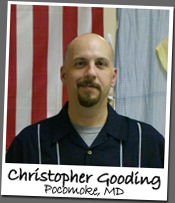As a social studies teacher, it might come as a surprise that I also run two STEM-related (Science, Technology, Engineering and Math) afterschool programs. I got involved in both programs during my second year of teaching in the Worcester County School System in Pocomoke, MD. The first program, Maryland MESA (Math Engineering Science Achievement), is a Maryland statewide organization sponsored by the John Hopkins University Applied Physics Laboratory. I initially got involved in MESA as a parent helper because my son was on the team. The volunteer opportunity was a great father-son bonding experience, and it gave me the chance to work with several students, training them to think outside of the box. When the club needed a new advisor, I jumped at the opportunity to serve in a bigger role. My favorite part of the position is working with the students as they develop their problem-solving capabilities. This year, one of the MESA projects involved the “Basswood Bridge”, which challenged students to engineer a bridge that can withstand the most weight while weighing less than 30 grams. Another project sharpened the students' public speaking as well as their inquiry skills through a PowerPoint presentation on renewable forms of energy. Most impressively, my students worked to build a multi-task windmill capable lifting the greatest mass in the shortest amount of time possible. The team won the Maryland state MESA championship and is headed to the national competition in Denver, Colorado this summer. The second afterschool program, PMS Engineering Club, is an initiative that I created. I saw a need to help our students tackle more difficult math and science projects outside of the classroom. Specifically, I wanted to develop a project-based curriculum that emphasizes hands-on experiences, teaches core math and science concepts and that provides opportunities for creative problem-solving. First, I made sure that students learned about basic engineering principles and tool safety. Next, we worked on strengthening their writing and drawing skills to help them become better communicators and better scientists. Leadership development is also a key part of the curriculum. Together, the students and I have decided upon what problems to solve and brainstormed engineering designs. My role as advisor is refining the students’ ideas and helping them build the models they invent. This year, the students built Trebuchets and several science fair projects. I feel that the PMS Engineering Club's supportive, nurturing and safe environment allows our students to build on their own interests. Through the projects and activities, they develop confidence and gain valuable hands-on experience - a critical reason why many will consider applying for STEM programs at the high school level. In fact, seven 8th graders in the PMS Engineering and MESA clubs applied and were accepted into our county’s Pre-Engineering and Bio-Medical Science STEM programs. Both the MESA and PMS Engineering afterschool programs are special to me because I am able to pass on knowledge and expertise in a way that few individuals get to do. Part of the fun for me and the students is just playing with the science tools-kits and learning from each other. Plus, the small student to teacher ratio in both programs allows all of the students to receive an immense amount of personal attention. It is incredible the tasks they can accomplish when prompted to expand their thinking. It is both an encouraging and proud moment when the "light bulb" turns on in their heads. It gives me great hope for the future to see children this young beginning to think in an unorthodox method. Growing up on a farm, I was always creative with what I found in the barn or in the garage. I had fun taking things apart to make something new. Now, with my students, I often feel like a "big kid" - just as happy as they are to sit on floor with my Legos or Tinker Toys. These types of activities are the stepping stones to big engineering projects, and afterschool is where it takes place for our middle school students. | 







